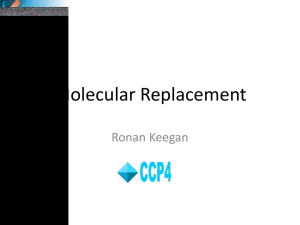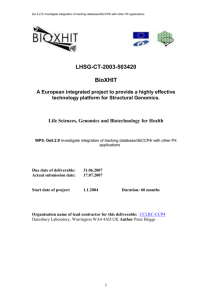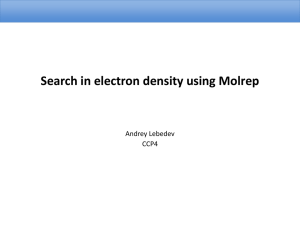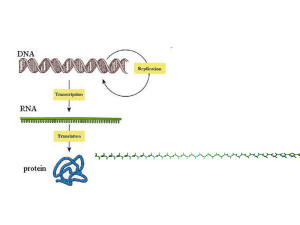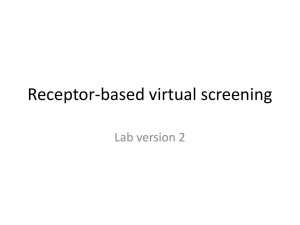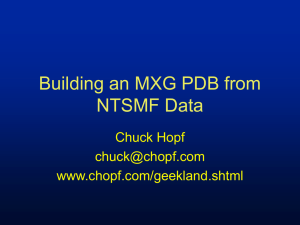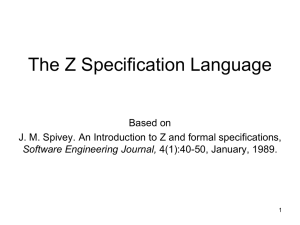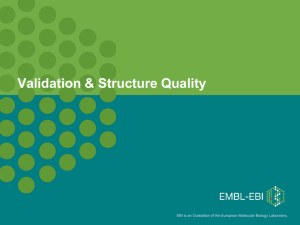Evaluating the Solution from MrBUMP and Balbes
advertisement
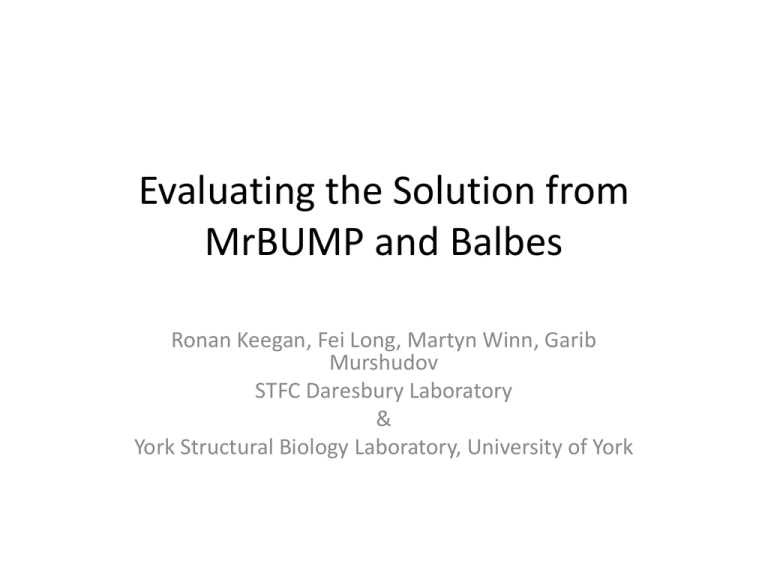
Evaluating the Solution from MrBUMP and Balbes Ronan Keegan, Fei Long, Martyn Winn, Garib Murshudov STFC Daresbury Laboratory & York Structural Biology Laboratory, University of York PDB Depositions (1999-2009) 1999 2009 What are MrBUMP and Balbes? • Automated molecular replacement (MR) and beyond.... • MrBUMP: – Brute force approach - try a variety of search models prepared in several different ways in MR • Balbes: – Identifies the best possible search model to be used in MR by using a specially grafted version of the PDB optimised for use in MR MrBUMP •An automation framework for Molecular Replacement. •Particular emphasis on generating a variety of search models. • Wraps Phaser and/or Molrep. • Uses a variety of helper applications (e.g. Chainsaw) and bioinformatics tools (e.g. Fasta, Mafft) to generate search models • Makes use of up-to-date on-line databases (e.g. PDB, Scop) •In favourable cases, gives “one-button” solution •In Complicated Cases, will suggest likely search models for manual investigation (lead generation) The Pipeline Target MTZ & Sequence Target ` Details Template ` Search N templates Model ` Preparation Check scores and exit or select the next model N x M models Molecular Replacement ` & Refinement Phase Improvement Search for model templates • FASTA search of PDB – Sequence based search using sequence of target structure All of the resulting PDB id codes are added to a list These structures are called model templates • Other templates from: o SSM search using top hit from the FASTA search o Can add additional PDB id codes to the list o Can add local PDB files Multiple Alignment step target model templates Jalview 2.08.1 Barton group, Dundee pairwise alignment (used in Chainsaw) currently support ClustalW, MAFFT, probcons or T-coffee for multiple alignment Model template scoring: score = sequence identity X alignment quality Domain 1 X Domain 2 SCOP Domains e.g. if relative domain motion PQS/PISA Multimers template chains superpose Better signal-tonoise ratio than monomer, if assembly is correct for the target. Ensembles Create ensemble of top search models, for use in additional run of Phaser. Need to be similar in MW and rmsd Search Model Preparation Search models prepared in four ways: PDBclip – original PDB with waters removed, most probable conformations selected and format tidied (e.g. chain ID added) Molrep – Molrep model preparation function which aligns the template sequence with the target more side sequence and prunes the non-conserved side chain chains accordingly. truncation Chainsaw – Can be given any alignment between the target and template sequences. Nonconserved residues are pruned back to the gamma atom. Polyalanine – Created by excluding all of the side chain atoms beyond the CB atom using the Pdbset program deal with deletions Molecular replacement step Running MR • For each search model, MR done with Molrep or Phaser or both. • MR programs run mostly with defaults • MrBUMP provides LABIN columns, MW of target, sequence identity of search model, number of copies to search for, number of clashes tolerated Molecular replacement step • MR output – MR scores and un-refined models available for later inspection assess quality of solution, extent of model bias – MrBUMP doesn’t use MR scores, but checks for output file with positioned model, and passes to refinement step Testing enantiomorphic spacegroups – 11 pairs of enantiomorphic spacegroups containing screw axes of opposite handedness, e.g. P41 and P43) – usually both need to be tested in MR – correct spacegroup indicated by TF and packing – MrBUMP can test both in Molrep and/or Phaser. – For each search model, best MR results used to fix spacegroup for subsequent steps. – Discrimination good for good search model + correct MR solution Inclusion of fixed models • MrBUMP will now accept one or more positioned models. • These are included as fixed models in all MR jobs. • Thus, solve complexes through consecutive runs of MrBUMP. • Automation of this in progress .... Restrained refinement step • The resulting models from molecular replacement are passed to Refmac for restrained refinement. • The change in the Rfree value during refinement is used as rough estimate of how good the resulting model is. final Rfree < 0.35 or final Rfree < 0.5 and dropped by 20% final Rfree < 0.48 or final Rfree < 0.52 and dropped by 5% otherwise conservative ..... “success” “marginal” “poor” Refinement results Summarised results.. Best search model so far and file location for this model List of sorted results so far Example (thanks to Elien Vandermarliere) Target is an arabinofuranosidase Data to 1.55Å in P212121 Small C domain (144 res) solved with 34% seq ident model (1w9t_B_MOLREP best out of 4 solutions) With C domain solution fixed, large N domain (345 res) solved with 28% seq ident model (1gyh_C_CHNSAW best out of 7 solutions) Acorn: CC increases from 0.04 to 0.18 This step part of MrBUMP ARP/wARP then builds 457/493 residues to R/Rfree 0.185/0.225 MrBUMP output Log file gives summary of models tried and results of MR • May get several putative solutions • Ease of subsequent model re-building, model completion may depend on choice of solution • Worth checking “poor” solutions Top solution available from ccp4i Using MrBUMP • Part of CCP4 suite • CCP4i GUI (Balbes) Fei Long, Alexei Vagin, Paul Young, Garib Murshudov YSBL, York University http://www.ysbl.york.ac.uk/~fei/balbes/index.html Balbes • Balbes uses a reorganised version of the PDB database customised for use in MR. • Has its own classification of domains most suitable for use in molecular replacement • Database also includes classification of possible oligomers based on the basic structures. • Built upon Molrep for molecular replacement and Refmac for doing the refinement Balbes Database • Cut down version of the PDB keeping only single copies of unique folds. • Where 2 entries have sequence ID > 80 % and rmsd < 1 angstrom, the entry with the highest resolution is retained • More than 20000 entries • More than 23000 domains classified • For each sequence additional information is stored including secondary structure information, number of domains and potential to form multimers • Flexible loops are cut from the stored structures • Multimers are classified with information from the EBI PISA service Balbes Workflow Assemblies • Fully automatic support for handling assemblies • Simply provide additional sequences in input sequence file for each additional component in the target data • Balbes will first look for assemblies in its database containing all of the sequences but if not find it will look for subsets of those sequences Using Balbes • Through CCP4i: – included in Linux and Mac OSX releases – Simple CCP4i interface - provide sequence and structure factor file (MTZ) – Enter multiple sequences in input file for complexes Using Balbes • Through the YSBL Web Server: – Balbes is one of several programs available to use via the web at the York University YSBL Web Server – Create an account for access http://www.ysbl.york.ac.uk/YSBLPrograms/index.jsp Balbes Web Server • Enter MTZ and sequence information as a file or paste sequence • Option to check all related space groups • Option to submit resulting map to ARP/wARP server for final model building Web Server Results • Summary of processing for each spacegroup • Final best result highlighted • For each spacegroup log file and all output files are made available for download (5 days) • If user opted to use ARP/wARP server a link to the ARP/wARP results is provided Balbes Output • Spacegroup specific output: – Download files – Main summary file showing results of MR and refinement for each template model that was used. – Q value scoring Balbes – the statistics • In 2006, 67% of structures deposited in the PDB where solved by MR • Balbes improved this to 80% using – A better organised database (for MR) – A better choice of protocols for tackling the MR problem – Improved algorithms in MR and refinement programs Balbes Usage • 90 structures in PDB referencing use of Balbes as part of structure solution • 35 citations • More than 5000 users of web server version of program • ~ 150 users per month Summary • MrBUMP: – Brute force approach, try everything – May give lead in borderline cases as well automating straight-forward cases – All results are easily accessible and summarised • Balbes: – Efficient and quick at solving structures that have reasonable homologues – Deals with assemblies/complexes fully automatically – Combined with ARP/wARP it can take structure nearly all the way to completion • In conclusion: – Try Both!! Compute cycles are very cheap. Acknowledgements • Fei Long, Alexei Vagin, Paul Young, Andrey Lebedev, Garib Murshudov – Balbes and Refmac • Martyn Winn, MrBUMP • Airlie McCoy, Randy Read – Phaser • Alexi Vagin – Molrep • Norman Stein – Chainsaw and Ctruncate • CCP4 Core team – Support and Testing Downloading Balbes Database – Balbes database available as a separate download (1.6GB) PDB Statistics • The number of structures in the PDB is increasing rapidly year on year • By the end of 2009 there were > 62000 structures deposited • 7449 structures were deposited in 2009 (12 % of the total) • MrBUMP and Balbes seek to exploit this wealth of data to improve the success rate of molecular replacement
